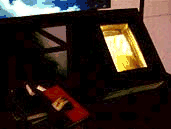
|
Now, I would like to show a short videotape about the first
computer-controlled interactive artwork I made, a 1991 work titled "The
Surprising Spiral". The narration on this tape, and the others you will
see tonight, are contemporaneous with the projects they document, and I
think it's interesting to listen, too, (at least for me) to how my sense
of discussing this work also changes over time.

Because it connects to known forms, such as the shrine or the
vending-machine, the circuit described between the desire to "get
something" from the work and the expectation of a "return" informs the
basic drive in the interactive encounter. The Surprising Spiral
brought this to my attention quite clearly. The structure of t he work is
such that the viewer-participant cannot "know" what effects their actions
will produce. What I learned was that many who encountered this work were
frustrated by their inability to "get what they wanted", to control the
work. Interactivity is , in many ways, about affirmation of the human
action by a nonhuman object, a narcissistic "it sees me". But beyond
that, there is the desire for "control", for "mastery" over the non-human
entity. I also learned that it is a rare viewer who feels comfortable in
the role of public participant in an interactive work which has no
clear "goal". People always seem to ask the same questions when the
"destination" of the interaction is unclear - "How is it structured?", "Is
it random?", "How can I get what I want (or see what I want to see)?", "Am
I doing it right?", "What will happen if I do 'this' or 'that'?"
|
|




